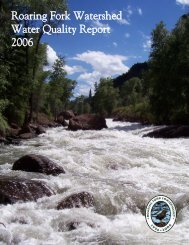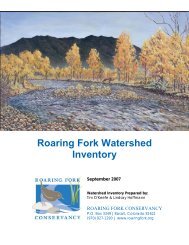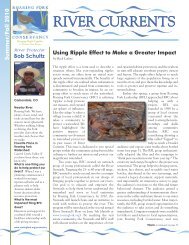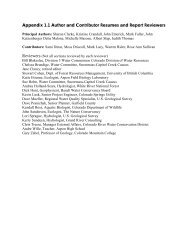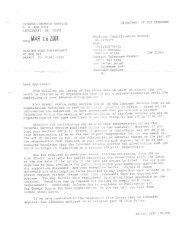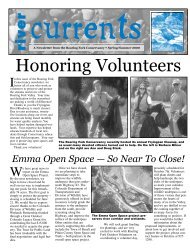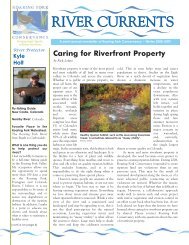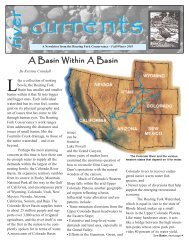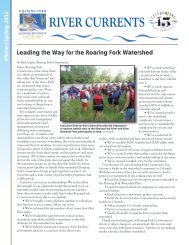<strong>Transmountain</strong> <strong>Diversion</strong> Project. Today, that project diverts up to 39,292 acre-feet <strong>of</strong> water annually from theheadwaters <strong>of</strong> the Roaring Fork River to the Arkansas River Basin. 16<strong>The</strong> Colorado-Big Thompson ProjectBy the 1930s many <strong>of</strong> the easier transmountain diversions were already built, <strong>and</strong> further developmentrequired increasingly elaborate <strong>and</strong> costly projects. 17 At the same time, the first summers <strong>of</strong> the Dust Bowl scorchedthe plains, ruining nearly $47 million <strong>of</strong> crops in the eastern half <strong>of</strong> Colorado. 18 <strong>The</strong> growing sense <strong>of</strong> urgency amongfarmers spurred Colorado to push for federal support <strong>of</strong> a major transmountain diversion project that would divertwater from the headwaters <strong>of</strong> the Colorado River to the South Platte River Basin. 19 While the proposal initiallygenerated stiff opposition from West Slope <strong>and</strong> environmental interests, in 1937 Congress authorized the Bureau <strong>of</strong>Reclamation to build the Colorado-Big Thompson (C-BT) Project. 20With 12 reservoirs, 35 miles <strong>of</strong> tunnels, <strong>and</strong> 95 miles <strong>of</strong> canals, construction <strong>of</strong> the C-BT Project would takenearly two decades. Project water was first diverted from Gr<strong>and</strong> Lake to the East Slope in 1957, through the 13.1-mileAlva B. Adams Tunnel underneath Rocky Mountain National Park <strong>and</strong> the Continental Divide. Today, the C-BT isColorado’s largest transmountain diversion project, diverting approximately 213,000 acre-feet <strong>of</strong> water on averageeach year from the headwaters <strong>of</strong> the Colorado River to the South Platte River basin. Altogether the project providessupplemental water to thirty cities <strong>and</strong> towns <strong>and</strong> allows for the irrigation <strong>of</strong> roughly 693,000 acres <strong>of</strong> l<strong>and</strong> innortheastern Colorado.One <strong>of</strong> the issues that had to be resolved before Congress would authorize the C-BT Project was thepotential impacts to water users on Colorado’s West Slope. 21 While the West Slope was sparsely populated,agriculture was already well established, thanks largely to the earlier construction <strong>of</strong> two major irrigation projects bythe Bureau <strong>of</strong> Reclamation. 22 West Slope residents had no intention <strong>of</strong> st<strong>and</strong>ing by as the headwaters <strong>of</strong> the ColoradoRiver were diverted to the Front Range, initially dem<strong>and</strong>ing acre-foot for acre-foot compensation for any water takenfrom the Colorado River. 23 Eventually the two sides <strong>of</strong> the divide reached a compromise in the form <strong>of</strong> GreenMountain Reservoir, a component <strong>of</strong> the C-BT Project that was built as compensatory storage for existing <strong>and</strong> futureWest Slope water dem<strong>and</strong>s. 24 With a capacity <strong>of</strong> approximately 153,000 acre-feet, Green Mountain Reservoir providesenough storage to satisfy senior water rights in the Colorado River Basin, as well as an additional 20,000 acre-feet <strong>of</strong>water that the Bureau <strong>of</strong> Reclamation contracts out to West Slope water users. 25Later Compensatory Storage <strong>Projects</strong>With the agreement brokered for the C-BT Project as a model, in 1943 the Colorado General Assemblyamended the Water Conservancy Act to make compensatory storage a requirement for any project exporting waterfrom the Colorado River Basin that is owned or operated by a water conservancy district. 26 In the following decades,this compensatory storage requirement served as the foundation for the construction <strong>of</strong> additional transmountaindiversion projects, both federal <strong>and</strong> nonfederal. In 1962 Congress authorized the construction <strong>of</strong> the Fryingpan-Arkansas Project, after West Slope interests <strong>and</strong> the Southeastern Colorado Water Conservancy District agreed to theconstruction <strong>of</strong> Ruedi Reservoir as the compensatory storage component <strong>of</strong> the project. Likewise in 1970 theMunicipal Subdistrict for the Northern Colorado Water Conservancy District was permitted to construct the WindyGap Project (a major expansion <strong>of</strong> the C-BT Project) after the Subdistrict agreed to provide financial support for theconstruction <strong>of</strong> Wolford Mountain Reservoir. 27However since the Water Conservancy Act only applies to water conservancy districts, just three <strong>of</strong> thenearly thirty transmountain diversion projects in Colorado are subject to the compensatory storage requirement (seeRoaring Fork Watershed Plan!Phase II Guidance Document – Appendix Iii
Figure 2. <strong>Transmountain</strong> diversions in Colorado. <strong>The</strong> only diversions subject to the compensatory storage requirement are thosethrough the Adams Tunnel (8) (C-BT <strong>and</strong> Windy Gap projects) <strong>and</strong> the Boustead Tunnel (19) (Fryingpan-Arkansas Project). (StateEngineers Office)Figure 2). 28 <strong>The</strong> concept <strong>of</strong> compensatory storage is also increasingly limited as a tool for negotiation between East<strong>and</strong> West Slope water interests. 29 One <strong>of</strong> the main reasons for the diminished interest in compensatory storage is thereduced dem<strong>and</strong> for additional water storage on the West Slope. 30 Numerous reservoirs on the West Slope alreadyprovide for the storage <strong>of</strong> spring run<strong>of</strong>f, <strong>and</strong> the availability <strong>of</strong> other feasible reservoir sites is limited. 31 Moreover,the West Slope is transitioning from a mining <strong>and</strong> agricultural based economy to one increasingly centered aroundtourism <strong>and</strong> second-home ownership, both <strong>of</strong> which value the environmental <strong>and</strong> recreational benefits provided bymaintaining instream flows. 32<strong>The</strong> Two Forks <strong>and</strong> Homestake II <strong>Projects</strong><strong>The</strong> potential roadblock that environmental <strong>and</strong> recreational interests pose to additional transmountaindiversion projects was demonstrated by the relatively recent defeat <strong>of</strong> two major water supply projects for the FrontRange. In 1990, after nearly fifty years <strong>of</strong> planning <strong>and</strong> more than $40 million spent on various feasibility studies, theEnvironmental Protection Agency (EPA) vetoed Denver Water’s Two Forks Project, based on the potential impact t<strong>of</strong>isheries, wildlife, <strong>and</strong> recreational values. 33 Two years later, after more than two decades <strong>of</strong> fierce litigation, localinterests in Eagle County also successfully defeated the Homestake II Project, again based on environmentalconcerns, in particular, the potential impacts to wetl<strong>and</strong> areas in the recently-formed federal Holy Cross WildernessArea. 34Both the Two Forks <strong>and</strong> Homestake II projects were ultimately defeated because their proponents failed toaccount for the impacts associated with transmountain diversions on environmental <strong>and</strong> recreational values in thebasin-<strong>of</strong>-origin. While local environmental <strong>and</strong> recreational interests will never be paramount to the need to ensureRoaring Fork Watershed Plan!Phase II Guidance Document – Appendix Iiii



